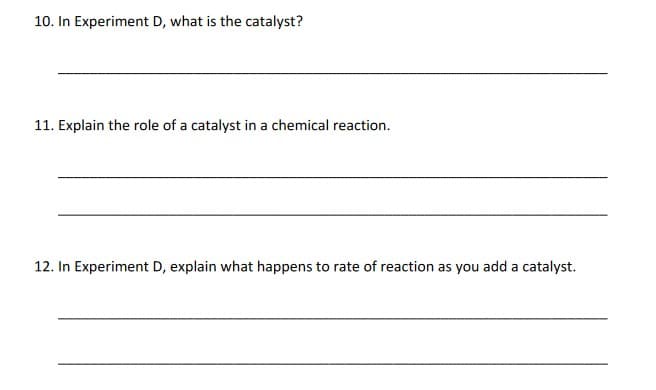10. In Experiment D, what is the catalyst? 11. Explain the role of a catalyst in a chemical reaction. 12. In Experiment D, explain what happens to rate of reaction as you add a catalyst.
THE QUESTION IS AT THE PICTURE... 2 QUESTIONS ONLY.. AND THE GIVEN PROBLEMS IS THE ONE I TYPED
A. Concentration
1. Place 3 mL each of 6N, 3N, & 1.5N hydrochloric acid in separate test tubes.
2. Drop simultaneously equal lengths (about 1cm) of magnesium ribbon and note the
time it takes for the magnesium to dissolve in each use.
B. Surface Area
1. Weigh a small iron nail to the nearest hundredths of a gram and weigh an equal
amount of iron fillings.
2. Place them in a separate test tubes.
3. Add simultaneously 3 mL of 3N hydrochloric acid and compare the rates of reaction.
C. Temperature
1. Place 5 mL each of 0.1N sodium thiosulfate solution into 5 test tubes.
2. Place all five test tubes in the water bath and let it stand for 1 minute.
3. Record the temperature of the water bath. Remove the first test tube from the
water bath and place it in the test tube rack.
4. Add 1 mL of 0.1M sulfuric acid and stir with a glass rod. Record the time it takes for
the turbidity to appear.
5. Increase the temperature of the water bath by about 10℃, as you remove the 2nd
test tube and do step 4.
6. Do the same with the 3rd, 4th, and 5th test tubes with 10℃ rise in the temperature.
D. Catalyst
1. Mix 0.5 mL of 6N sulfuric acid and 1 mL saturated oxalic acid solution. Add 1 mL of
0.1N potassium permanganate solution. Record the time it takes for the
permanganate color to completely disappear.
2. Repeat the above experiment, but at this time add 1 mL of 1M manganese sulfate solution before adding the potassium permanganate solution.
Note the time it takes
for the disappearance of the permanganate color.

Trending now
This is a popular solution!
Step by step
Solved in 2 steps









